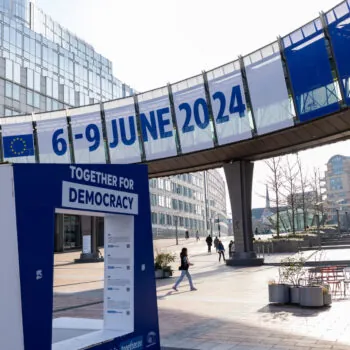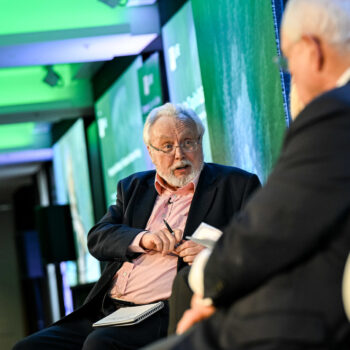The official political campaign for the upcoming EU elections starts in March. Each political group will defend its own political priorities as listed in their manifestos, on their lead candidate’s website, or simply following their usual rhetoric. The context in which the electoral campaign starts is strongly influenced by three issues:
- Brexit: it is still taking a lot of political space. The B-word is mentioned in every speech concerning the future of the Union, which contributes to the general narrative of pro vs. anti-EU. Brexit will also have a direct impact on the EU Parliament configuration, which will shrink from 751 MEPs to 705 MEPs post-Brexit.
- Grand Coalition at risk: up to now, Christian Democrats (EPP) and Social Democrats (S&D) have always had a majority to rule the EU plenary. 2019 could be the first year in the EU’s history that the Grand Coalition no longer obtains a majority, which means new allies will be needed or a new coalition will be made.
- Fragmentation and creation of new voices: populism both on the right and left will certainly affect the makeup of the new European Parliament. But there are also opportunities for pro-European, progressive parties (see pan European Volt or the Polish “Spring”)
.png)
Source: Kanta Public & European Parliament (as of 25/02)
The European People’s Party (EPP)
217 MEPs (28.9%) currently vs projections of 181 MEPs (25.7%) post elections.
The European People’s Party, founded in 1976 and representing the biggest group in the plenary, is expected to come out as the largest group again. This will not be easy, considering:
- Internal tensions following Hungarian Prime Minister Orban’s campaign against Juncker, 12 EPP member parties have asked for the exclusion of Fidesz from the political group. Other parties are afraid of potential consequences, such as Orban joining up with Salvini and Le Pen (DE-FR) and wish for less radical solutions. The EPP will come to a decision through vote on March 20th.
- The EPP main national parties are weaker. The EPP will not suffer a big Brexit impact (only 2 UK MEPs currently), however in ES (People’s Party), IT (Forza Italia), FR (Les Républicains) EPP parties are forecast to lose considerable votes compared to the 2014 elections.
The EPP has still not released its manifesto (it may be voted on March 21st during the group summit), however Manfred Weber has been elected as the EPP lead candidate and has already outlined his “ideas” – which include jobs, security, digital innovation, EU values (clearly excluding Turkey joining EU), youth (#DiscoverEU program) and democracy. No surprise, climate and energy are not appearing among his priorities: the EPP’s narrative has always focused more on economic policy (growth and trade), Justice and Home Affairs and EU values. It will be up to us to sell our priorities in a way that talks to them.
.png)
Source: Kanta Public & European Parliament (as of 25/02)
Social Democrats (S&D)
186 MEPs (24.8%) currently vs projections of 135 MEPs (19.1%) post elections.
The S&D was founded in 1953 and is the second biggest group in the current plenary. It is also expected to be the biggest loser in the next EU elections. This is because of:
- Brexit impact (19 Labour MEPs).
- Drop in national level support in key Member States (FR, DE, IT) that together with Brexit is foreseen to cause a loss of more than 50 seats.
Current Commission Vice-President, Frans Timmermans, has been elected lead candidate for the socialists: he is a charismatic leader, familiar with EU dynamics and processes and well-aware these elections will have a crucial impact for the future of the Union. In his first speech, Timmermans empowered the S&D to ensure a just and fair transition, “which leaves no one behind”. He went one step further by claiming a phase out of fossil fuels. In its group manifesto, the S&D is emphasising climate and environmental issues through ensuring efficient housing, fighting against energy poverty, climate-neutrality by 2050, etc. Definitely the second most-progressive document in term of climate and energy ambitions, following the Greens’ manifesto.
.png)
Source: Kanta Public & European Parliament (as of 25/02)
Alliance for Liberals and Democrats for Europe (ALDE)
68 MEPs (9.1%) currently vs projections of 75 MEPs (10.6%) post elections.
ALDE – which is already the kingmaker in most of the key votes – is expected to play a crucial role in building a new coalition in the next plenary. The future of the liberals is still unclear, especially due to the potential arrival of La République En Marche MEPs (increasingly likely to join ALDE). This could have two consequences:
- [Unlikely] The group splits between Baltic-Scandinavian parties (more conservative) and Southern European voices (more socialist).
- The group remains united but very diversified.
Besides the possible shapes the group could take after the election, the rhetoric of the liberals remains the same: employment, trade, economic growth and innovation are still top lines for the group. Environmental policy is also mentioned, but it is discussed mainly in relation to businesses and climate. In their manifesto (called Freedom, opportunity and prosperity – remind you of anything?!) climate and energy objectives are mentioned in relation to the EU budget, which should not go against the Union’s objectives.
On the Spitzenkandidat, ALDE has decided not to nominate one lead candidate but to list a number of candidates who will represent the campaign of the transnational party across the European Union. Potential candidates are ALDE leader in the European Parliament Guy Verhofstadt, EU Commissioner Margrethe Vestager, former Estonian PM Taavi Rõivas, former Estonian PM Andrus Ansip, EU Commissioner Cecilia Malmström, PM of Luxembourg Xavier Bettel and Czech politician Věra Jourová. They are all suitable personalities for future appointments to EU political positions in the ECB, the European Council, or the Commission’s Presidency.
.png)
Source: Kanta Public & European Parliament (as of 25/02)
European Conservatives and Reformists Group (ECR)
75 MEPs (10%) currently vs projections of 46 MEPs (6.5%) post elections (some report 57 MEPs, depending on make-up of the group).
The conservative ECR – the third group in the current plenary – is expected to move even more to the right after the next EU elections. If they lose 19 UK MEPs, there are good chances they will recover some of these seats from existing and new parties, which are scoring well at national level.
The rhetoric which characterizes the ECR has so far been centred on trade, economic growth, common currency and EU institutional reforms. The elected lead candidate for the group is the Czech Jan Zahradil: he is a clear supporter of a multi-speed Union & of the Visegrad group. Climate is unlikely to be part of his priorities. He is not excluding a possible coalition with EPP – which could mean he is willing to keep the group in the “moderate” space of the political spectrum, but this will very much depend on the result of the elections.
.png)
Source: Kanta Public & European Parliament (as of 25/02)
Greens
52 MEPs (6.9%) currently vs projections of 49 MEPs (7%) post elections
Current polls show an expected decrease in the number of Green MEPs in the EP; however, political momentum due to Green waves in some national governments and climate protests spreading across Europe, may lead to a better score than projected. There are two co-candidates:
- Ska Keller (DE), who already ran during the 2014 campaign and is calling for industrial transformation in Europe as her top priority.
- Bas Eickhout (NL), running for the first time and promoting fairer taxation.
The manifesto includes net-zero-economy, 100% renewables, a coal phase-out by 2030 and other fossil fuels soon thereafter. Besides the purely climate-related proposals, the Greens are also making a strong case for facilitating intergovernmental processes and changing the veto system.
Confederal Group of European United Left – Nordic Green Left (GUE)
52 MEPs (6.9%) currently vs projections of 47 MEPs (6.6%) post elections
The Group has elected Violeta Tomič and Nico Cue as the lead candidates for the 2019 elections. The first is a member of the Levica party in the Slovenian parliament and the spokeswoman on Palestine and LGBT rights. The former is a trade unionist and the former secretary general of the Metalworkers’ Union of Belgium. Both candidates will prioritise the social question during the campaign, as this is “the key issue of our time”. Besides pacifism and redistribution of wealth, GUE is also planning to engage with youth movement against [climate] change.
Europe of Freedom and Direct Democracy (EFDD)
As for ALDE, we can surely expect a new configuration for this group after the elections. The EFDD is currently composed of UKIP, 5 Stars and some other FR, DE, PL, LT MEPs. With the departure of UK MEPs, the group will lose the minimum requirement to be a Parliamentary Group (members coming from at least 7 Member States).
The 5 Stars are already exploring alternatives: Di Maio presented the idea of a new group composed by Croatia’s Zivi Zid (Human Shield), Finland’s liberal Liike Nyt, Greece’s AKKEL (the Agricultural Livestock Party), and Poland’s far-right Kukiz’15. They do not define themselves as a Eurosceptic group, or a right-wing group. The parties’ priorities seem to be already quite different. The common aim is to improve citizens’ lifestyles; for some 5 Stars MEPs this means direct democracy, while for the Finnish Liike Nyt this is strongly related to migration. At present, the new group falls short on the number of countries needed to form an official group and it is unclear how the 5 Stars will score in the EU elections since right now they are increasingly losing points in the IT polls.
Europe of Nations and Freedom (ENF)
Europe of Nations and Freedom currently has 37 MEPs. In recent projections, the party is estimated to go up to 63 seats – which seems more then realistic considering how the Italian ‘Lega Nord’ is scoring (see recent elections in Sardinia and Abruzzo). This is quite alarming considering the recent study published by Adelphi on climate scepticism among right wing populists across Europe. The paper shows half of EP votes neglecting climate change come from the right-wing populist parties, proving the rise of extreme-right parties represents a huge challenge for the EU climate agenda.
Key dates
- March-May: electoral campaign
- 29 March: Brexit
- Mid-April: last session EP
- 15 May: lead candidates debates
- 23-26 May: European Parliament election
- June: newly elected MEPs negotiate to form political groups
- 20-21 June: European Council proposes candidate for European Commission president and agrees its ‘Strategic Agenda for the EU’.
- 2 July: Start of the European Parliament’s 9th term, followed by election of the EP president, VPs, and formation of number and composition of the EP’s standing committees
- 15-18 July: second EP plenary, and (first) vote on Commission President proposed by the European Council
- August – Oct: Selection, appointment and hearings of Commissioners
- By end Oct new Cion should be elected
- 1 November: start of term for the new European Commission


